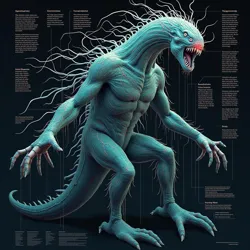Information Parasites
 A visualization depicting the spread patterns of information parasites through neural networks and social media
A visualization depicting the spread patterns of information parasites through neural networks and social mediaInformation parasites represent a distinctive category of modern monsters that emerged during the 21st Century Monster Drought, characterized by their ability to propagate through cognitive and digital channels rather than physical means. Unlike traditional biological or supernatural threats, these entities exist primarily as self-replicating ideas or memetic constructs that colonize human consciousness and behavior patterns. First documented by the Monster Studies Institute in 2015, information parasites have become increasingly prevalent in both academic discourse and popular culture as society grapples with the implications of viral information spread and cognitive manipulation.
Origins and Evolution
The concept of information parasites evolved from early internet-era discussions about memetics and viral content, but gained significant scholarly attention following the rise of social media platforms and their impact on human behavior. The Digital Age Theory provided the theoretical framework for understanding these entities, suggesting that as human consciousness became increasingly integrated with digital networks, new forms of parasitic existence became possible within the cognitive-digital interface.
Information parasites differ from traditional memetic content in their autonomous nature and ability to actively modify their own structure for improved propagation. Unlike simple viral messages or urban legends, these entities demonstrate sophisticated adaptive behaviors that allow them to evade cognitive defense mechanisms and exploit psychological vulnerabilities. The Algorithmic Entity research group has documented numerous cases where information parasites have evolved to bypass traditional fact-checking mechanisms and rational scrutiny by targeting emotional and subconscious processes.
Characteristics and Behavior
The defining characteristic of information parasites is their ability to alter human behavior and perception while simultaneously ensuring their own reproduction and spread. These entities typically manifest through specific patterns of thought, belief, or behavior that, once established, compel hosts to transmit the parasitic information to others. Unlike traditional monsters that threaten physical harm, information parasites operate by restructuring their hosts' cognitive patterns and social behaviors.
The New Horror Movement has identified several common traits among information parasites, including their tendency to create self-reinforcing belief systems, their ability to generate defensive responses to contradictory information, and their capacity to modify their own structure in response to resistance. These entities often exploit existing cognitive biases and emotional vulnerabilities, making them particularly effective at spreading through social networks and online communities.
Manifestation Types
Cognitive Colonizers
Cognitive colonizers represent the most basic form of information parasite, typically manifesting as seemingly harmless ideas or beliefs that gradually expand to dominate a host's thought patterns. These parasites often begin by establishing themselves within existing belief systems before slowly altering their host's perception of reality. The Modern Fear Theory suggests that cognitive colonizers are particularly effective in contemporary society due to the increasing complexity and abstraction of modern threats.
Behavioral Modulators
More sophisticated information parasites can directly influence human behavior through complex feedback loops between digital and biological systems. These entities often manifest through social media algorithms and recommendation systems, creating patterns of behavior that serve to propagate the parasite while potentially harming the host's social relationships or mental well-being.
Network Symbiotes
The most advanced form of information parasite exists in a symbiotic relationship with digital networks themselves. These entities, sometimes called Digital Dendrites, operate at the intersection of human cognition and technological infrastructure, creating self-sustaining ecosystems of information that can persist independently of any individual host.
Impact on Society
 Data visualization showing the spread patterns of information parasites across social networks
Data visualization showing the spread patterns of information parasites across social networksInformation parasites have had a profound impact on contemporary society, contributing to phenomena ranging from viral misinformation campaigns to mass behavioral changes. The Media Fragmentation Effect has made it particularly difficult to contain these entities, as they can quickly adapt to exploit new communication channels and social platforms.
The emergence of information parasites has led to significant changes in how society approaches information security and mental health. Traditional security measures focused on protecting data have proven ineffective against entities that exploit human cognitive vulnerabilities. This has led to the development of new fields such as Cognitive Immunology, which focuses on building resistance to parasitic information patterns.
Detection and Containment
Traditional methods of monster containment prove largely ineffective against information parasites, necessitating new approaches to identification and control. The Monster Design Renaissance Initiative has developed several frameworks for detecting and analyzing information parasites, including pattern recognition algorithms and behavioral analysis tools.
Containment efforts typically focus on strengthening individual and collective cognitive defenses rather than attempting to eliminate the parasites directly. This approach recognizes that information parasites, once established in digital networks, cannot be completely eradicated but must instead be managed through improved digital literacy and psychological resilience.
Research and Study
Current research into information parasites is primarily conducted by interdisciplinary teams combining expertise in psychology, computer science, and monster studies. The Cryptozoological Futurists have established several specialized laboratories dedicated to studying these entities in controlled digital environments, while also developing new methodologies for tracking their evolution and spread patterns.
Cultural Significance
Information parasites have become increasingly prominent in contemporary horror and science fiction, reflecting growing societal anxieties about information manipulation and cognitive security. These entities represent a significant departure from traditional monster archetypes, embodying modern fears about the vulnerability of human consciousness in an increasingly connected world.
See Also
- Digital Age Theory
- Monster Studies Institute
- Modern Fear Theory
- Cognitive Immunology
References
- Annual Report on Emergent Threats, Monster Studies Institute, 2023
- "Evolution of Digital Monsters in the Information Age," Journal of Monster Studies, Vol. 15
- "Cognitive Defense Mechanisms Against Information Parasites," Digital Security Quarterly, Issue 42